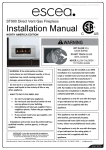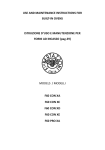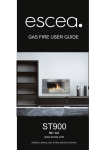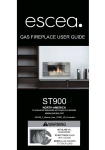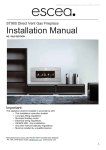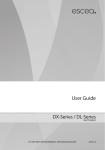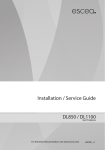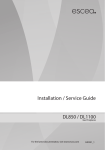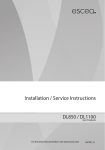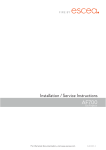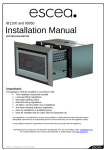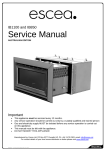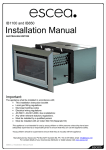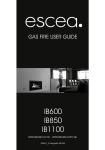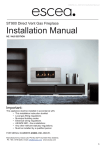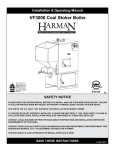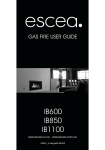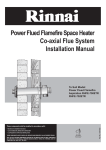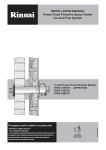Download Installation Manual
Transcript
630167_3_Manual_Installation_US_RͲemotion ST900 Direct Vent Gas Fireplace Installation Manual NORTH AMERICA EDITION WARNING:Iftheinformationinthese instructionsarenotfollowedexactly,afireor explosionmayresultcausingproperty damage,personalinjuryorlossoflife. ͲDonotstoreorusegasolineorotherflammable vaporsandliquidsinthevicinityofthisorany otherappliance. ͲWHATTODOIFYOUSMELLGAS x x x x Donottrytolightanyappliance. Donottouchanyelectricalswitchdonot useanyphoneinyourbuilding. Immediatelycallyourgassupplierfroma neighborsphone.Followthegassuppliers instructions. Ifyoucannotreachyourgassupplier,call thefiredepartment. ͲInstallationandservicemustbeperformedbya qualifiedinstaller,serviceagency,orthegas supplier. INSTALLER: Leave this manual with the appliance. CONSUMER: Retain this manual for future reference. Ce manual est disponsible en Français sur demande. www.escea.com ThisappliancemaybeinstalledasanOEM installationinamanufacturedhome(USA only)ormobilehomeandmustbeinstalled inaccordancewiththemanufacturer’s instructionsandtheManufacturedHome ConstructionandSafetyStandard,Title24 CFR,Part3280,intheUnitedStates,orthe StandardforInstallationinMobileHomes, CAN/CSAZ240MH,inCanada. Thisapplianceisonlyforusewiththetypes ofgasindicatedontheratingplate.A conversionkitissuppliedwiththe appliance. Thisappliancemaybeinstalledinan aftermarket,permanentlylocated, manufacturedhome(USAonly)ormobile home,wherenotprohibitedbylocalcodes. Thisapplianceisonlyforusewiththetypes ofgasindicatedontheratingplate.A conversionkitissuppliedwiththe appliance. Manufactured By: Escea International Limited, 375b Green Valley Road, Griffen, GA 30224 USA. Ph: 866 615 3096 | [email protected] 630167_3_Manual_Installation_US_RͲemotion Important: Theapplianceshallbeinstalledinaccordancewith; •Thisinstallationinstructionbooklet •Localcodesor,intheabsenceoflocalcodes,withtheNationalFuelGasCode,ANSI Z223.1/NFPA54,ortheNaturalGasandPropaneInstallationCode,CSAB149.1 •Amanufacturedhome(USAonly)ormobilehomeOEMinstallationmustconformwith theManufacturedHomeConstructionandSafetyStandard,Title24CFR,Part3280,or, whensuchastandardisnotapplicable,theStandardforManufacturedHomeInstallations ANSI/NCSBCSA225.1,orStandardforGasEquippedRecreationalVehiclesandMobileHousing, CSAZ240.4 •Anyotherrelevantstatutoryregulations. •Mustbeinstalledbyaqualifiedinstaller,serviceagencyorgassupplier •Convertingthisapplianceforusewithothergassesmustbedonebyaqualifiedinstaller,service agency,orgassupplier Warning: Ͳ Ͳ Ͳ Ͳ Ͳ Ͳ Ͳ Ͳ Ͳ Ͳ Duetohightemperatures,theST900shouldbelocatedoutoftrafficandawayfrom furnitureanddraperies. TheareaaroundtheST900MUSTbekeptclearandfreefromcombustiblematerials, gasolineandotherflammablevaporsandliquids. Childrenandadultsshouldbealertedtothehazardsofhighsurfacetemperatureand shouldstayawaytoavoidburnsorclothingignition. ClothingorotherflammablematerialshouldnotbeplacedonorneartheST900. AnysafetyscreenorguardremovedforservicingtheST900mustbereplacedpriorto operatingit. Installationandrepairshouldbedonebyaqualifiedserviceperson.TheST900shouldbe inspectedbeforeuseandatleastannuallybyaprofessionalserviceperson.Morefrequent cleaningmayberequiredduetoexcessivelintfromcarpeting,beddingmaterial,etcetera. Itisimperativethatcontrolcompartments,burnersandcirculatingairpassagewaysofthe ST900bekeptclean. Donotusethisapplianceifanyparthasbeenunderwater.Immediatelycallaqualified servicetechniciantoinspecttheapplianceandtoreplaceanypartofthecontrolsystem andanygascontrolwhichhasbeenunderwater. Caution:Labelallwirespriortodisconnectionwhenservicingcontrols.Wiringerrorscan causeimproperanddangerousoperation. Verifyproperoperationafterservicing. Youngchildrenshouldbecarefullysupervisedwhentheyareinthesameroomasthe appliance.Toddlers,youngchildrenandothersmaybesusceptibletoaccidentalcontact burns.Aphysicalbarrierisrecommendedifthereareatriskindividualsinthehouse.To restrictaccesstoafireplaceorstove,installanadjustablesafetygatetokeeptoddlers, youngchildrenandotheratriskindividualsoutoftheroomandawayfromhotsurfaces. 630167_3_Manual_Installation_US_RͲemotion Note: THERE ARE A FEW THINGS TO CONSIDER BEFORE INSTALLATION • Cavity Dimensions and Clearances • MUST be installed a minimum of 4” above the floor or nearest horizontal surface. • Coupling of flue to fireplace • Gas pipe placement to the front left of the cavity. • Coupling of gas lines to fireplace • Fixing the fireplace to cavity • Before installation, ensure that the local distribution conditions (identification of the type of gas and pressure) and the adjustment of the appliance are compatible. • A list of replacement parts is in Appendix D at the end of this Installation Manual The sequence in which you choose to do these tasks will vary depending on your individual scenario. Please read these instructions fully before proceeding with the installation. Leave the installation of the fascia panels until the very end of the installation and commissioning to avoid damage to the fascia panels. Recommended Installation Process: The following diagram illustrates the steps required to install your gas fireplace, and the trades required at each stage. Builder 1.ConstructFrame(Section1.0to6.0) Gasfitter 2.InstallGasPipe(Section7.0to8.0) 3.InstallFireplace(Section9.0to11.0) Ensurethatyouleaveagapbetweenthestudworkandfire chassistoacceptthewallliningifapplicable. Gasfitter 4.InstallFlue+FlueRestrictorifrequired(Section12.0to13.0) 5.Testfireplaceandverifyflamepatternisacceptable 6.CoverͲupfireplaceusingpackaging(Section18.0) Builder 7.Drywall/cladchimneybreast Gasfitter 8.CommissiontheGasFireplace(Section18.0) 630167_3_Manual_Installation_US_RͲemotion Contents: 1.0 2.0 3.0 4.0 5.0 6.0 7.0 8.0 9.0 10.0 11.0 12.0 13.0 14.0 15.0 16.0 17.0 18.0 19.0 20.0 21.0 22.0 23.0 24.0 25.0 Product Description Creating the Cavity Hearth and Floor Clearances Wall Linings Vertical Clearances Corner Installations Laying Gas Pipe Connecting Gas Pipe Power Supply Fixing Fireplace to Wall Removing the Firebox Glass Installing the Flue system Fitting the Flue restrictor Converting to Propane Gas Placing the Fuel Bed Re-fitting the Glass Assembly Checking Operating Pressure Covering up the Fireplace Commissioning the Fireplace (Including fitting the fascia) Operating Instructions Sounds and Smells Annual Service Check Installation Check List Appendix Warranty Terms and Conditions WARNING: Failure to follow these instructions could cause a malfunction of the fireplace, which, could result in death, serious bodily injury, and/or property damage. Failure to follow these instructions may also void insurance cover and/or product warranty. Installation: Installation must be carried out by a registered installer who, on completion of the installation, must issue a certificate of compliance, in accordance with national and/or local codes. If a certificate of compliance is not issued then the Escea warranty may be void. Warranty Repair and Annual Servicing: Warranty repair work must be carried out by a recognised Escea gas fireplace service agency. It is recommended that recognised Escea Gas fireplace service agencies are also used to carry out annual servicing requirements (particularly during the warranty period). For contact details of authorised Escea service agencies in your area, please contact the retailer from whom the appliance was purchased. This product must be installed according to these instructions and in compliance with all relevant building, gas fitting and other statutory regulations (eg. ANSIZ223.1/NFPA54). Any shortcomings in the appliance and flue installation will be the responsibility of the installer, and Escea will not be accountable for any such failings or their consequences. 630167_3_Manual_Installation_US_RͲemotion 1.0 Product Description: The Escea ST900 decorative gas fireplace is designed to be built into a cavity. The appliance is flued via Simpson Duravent Direct Vent Pro 5” x 8” Flue, or compatible equivalent. The user will control their 35 ” fireplace with the Radio Frequency 17 ” 17 ” (RF) remote. The glass on the front of the appliance is considered a working surface, and as such care 13 ” should be taken not to touch this while the appliance is running as it will get hot. 1 13 2 13 16 16 15 16 13 34” 2 7 16 ” 44 7 16 ” 2213 16 ” 21 12” 15 5 16 ” 2.0 Creating the Cavity: The dimensioned drawing below shows the size of opening that must be created to fit the ST900. The wall directly above the fireplace should be finished / clad / lined after the fireplace has been installed, unless there is an access hatch or the chase is open to the ceiling cavity, which allows the flue to be installed after the wall has been lined. See Appendix C at the back of this installation manual for clearances to combustible materials. If the ST900 is installed directly on carpeting, tile or other combustiblematerial other than wood flooring, the appliance shall be installed on a metal or wood panel extending the full width and depth of the appliance. Note: It is not necessary to line or vent the cavity, and it may be constructed with timber. WallLining FramingTimber Thewallandframeworkinfront ofthefluemustnotexceed4”in thickness,thisincludesdrywall oranyotherwalllinings.Thisis toensurethereisatleast1”gap betweenallflueingcomponents andanycombustiblematerial. 100mm MAX Flue Diam. 203mm 630167_3_Manual_Installation_US_RͲemotion 3.0 Hearth and Floor Clearances: There should be at least 4” clearance between the bottom of the ST900 fireplace and any horizontal surface below, for example hearths and floors. 3.1 Wall and Cabinet Clearances: There must be a minimum of 4” clearance from the sides of the fascia to any protruding side walls or cabinetry. 4.0 Wall Linings: The wall board that lines the outside of this opening can be normal dry wall (Plaster Board) and does not need to be non-combustible providing that it does not come any closer to the fireplace than the dimensions shown in section 2.0. Note: The temperature of the wall lining directly above the fireplace does get warm and hence may discolour paint finishes that are susceptible to temperature damage or distort vinyl wall coverings. 5.0 Television Positioning Considerations: It is becoming common practice for consumers to mount flat screen TV’s above their gas fireplace. Most TV manufacturers have specified in their instructions that the TV should not be installed on, near or above a heat source. For this reason TV location decisions rest solely with the householder and Escea will not be held liable for any adverse affects on a TV located near to an Escea fireplace that may be caused by heat. The drawings below are suggestions that may be used as a GUIDE for those consumers who do decide to locate their TV above an ST900 gas fireplace. These drawings show ways to reduce the amount of warm air rising off the fireplace and onto the TV. Flush TV with small mantle Recessed TV Mantle above fire Protruding fire 2” 2” 2” 4” 2” 2” 2” 2” 4” Mantle Mantle 20” 20” 20” 20” 630167_3_Manual_Installation_US_RͲemotion The material that the wall and mantle are made from will also affect the operating temperature of the TV so it is the customers responsibility to satisfy themselves that their TV mounting and mantle design will not exceed the listed maximum operating temperature of their electronic goods. 5.1 Combustible Mantle Clearances: The diagram to the right shows the minimum and maximum allowable size for mantles or protruding surfaces mounted above the ST900. Note: Escea does not recommend placement of items on the mantles shown in the diagram to the right. This is because of the potential for items placed on or above the mantle to be affected by the heat rising from the appliance. 5.2 Non-Combustible Mantle Clearances: If the entire installation (mantle, wall and cavity) is constructed from non-combustible materials, the clearances to mantles may be as shown in the shaded area. 630167_3_Manual_Installation_US_RͲemotion 6.0 Corner Installations: If a cavity is to be created in a corner, the following drawing gives the minimum sizes. 7.0 Laying Gas Pipe: Gas pipe should be sized as per the requirements of relevant local or national codes. The pipe sizing must be sufficient to deliver the following volume of gas to the fireplace with all other gas appliances in the home running at the same time; ST900 = 19,500 BTU/h max on Natural Gas HighAltitudeInstallations When installing this appliance at an elevation above 2000 feet, it may be necessary to decrease the input rating by changing the existing burner orifice to a smaller size. Input rate should be reduced by 4% for each 1000 feet above a 2000 foot elevation in the U.S.A, or 10% for elevations between 2000 and 4500 feet in Canada. If the heating value of the gas has ben reduced, these rules do not apply. To identify the proper orifice size, check with the local gas utility. If installing this appliance at an elevation above 4500 feet (in Canada), check with local authorities. 8.0 Connecting the Gas Pipe: An accessible inline isolation or service valve must be fitted and pipe run to the fireplace as shown below. An inlet pressure test point must also be fitted to the inlet side of the appliance regulator. The regulator that is supplied with the fireplace MUST NOT BE REMOVED. Removal of the regulator, or replacing it with one not intended for use with an Escea fireplace, will void the limited appliance warranty. 630167_3_Manual_Installation_US_RͲemotion 9.0 Battery-Pack Power Supply: The ST900 runs on a battery pack. This battery pack uses 3x C cell batteries. To ensure that only fresh batteries are used, batteries are not supplied with the fireplace. To access the battery pack, remove the fascia (described in section 11.0) and the battery pack will be on the lower right hand side. The Battery Pack is secured in place with Velcro pads and may be removed by firmly pulling upwards. 10.0 Fixing the Fireplace to the base and wall: It is a requirement that this fireplace be securely fastened to the wall and base. Once the fireplace has been pushed back into the correct position, use wood screws (or other suitable fasteners) to fix the fireplace to the cavity through each of the four holes in the corners, as shown in the diagram to the right. Note: It may be necessary to use washers on the fasteners to securely fasten the fireplace to the wall. When fixing the fireplace in position ensure that you leave a gap between the fireplace flange and the framing timber for the wall lining, which will be added at a later stage. 11.0 Removing the Firebox Glass: Pull the four hooks shown below towards you and then away from the glass to release the glass frame underneath the hook. Do not operate the appliance if the glass has been broken, damaged, or the glass is not properly positioned/hooked onto the appliance. WARNING: Do not operate appliance with the glass format removed, cracked or broken. Replacement of the glass should be done by a licensed or qualified service person. 630167_3_Manual_Installation_US_RͲemotion 12.0 Installing the Flue System: Ensure all flue components are Simpson Duravent Direct Vent Pro 5” x 8,” or a compatible equivalent. Note: Consult Appendix A at the end of this installation manual (section 24.0) to ensure correct length of flue is calculated. There are two basic types of Balanced Flue System installations: • Horizontal Termination • Vertical Termination Use the diagrams in sections 12.5, 12.6 & 12.7 to check if your proposed flue system is acceptable. Section 12.9 will also need to be used to determine whether the flue terminal location meets the requirements of ANSI Z21.88-2009 Vented Gas Fireplace Fireplaces. Then use Appendix A to work out the quantities of the flue components that are required. This gas appliance must not be connected to a chimney flue serving a separate solid-fuel burning appliance 12.1 Any offsets in your flue configuration should be 45° where possible. 12.2 If your flue configuration has a horizontal run, there must be a minimum 1° inclination (3/4” vertical rise per 3’ horizontal run) leading upwards towards the termination. Do not install the flue with horizontal sections sloping down towards the termination. This could cause the fireplace to operate incorrectly and possibly create an unsafe condition. 12.3 The flue must maintain the following clearances to combustible materials; 1” from all sides and bottom of the flue, and 2” from the top of the flue. 12.4 If your flue configuration falls on or near a restriction zone boundary line in diagrams 12.5, 12.6 & 12.7, it may require the restriction value from either side of the boundary line to achieve the correct flame aesthetic, this may vary from installation to installation. 630167_3_Manual_Installation_US_RͲemotion 12.5 Vertical Only Flue Diagram: Usethisdiagramto determinewhat percentageofflue restrictionisrequiredto ensuresafeandcorrect operationoftheST900 DirectVentDecorative GasFireplace. SeeSection13.0 630167_3_Manual_Installation_US_RͲemotion 12.6 Horizontally Terminating Flue Diagram: Usethisdiagramto determinewhat percentageofflue restrictionisrequiredto ensuresafeandcorrect operationoftheST900 DirectVentDecorative GasFireplace. SeeSection13.0 630167_3_Manual_Installation_US_RͲemotion 12.7 Vertically Terminating flue with a Horizontal Offset: Usethisdiagramto determinewhat percentageofflue restrictionisrequiredto ensuresafeandcorrect operationoftheST900 DirectVentDecorative GasFireplace. SeeSection13.0 .. 630167_3_Manual_Installation_US_RͲemotion 12.8 Standard Flueing Configurations: The following flue components are available from your escea distributor/retailer in kitset form. DVFͲH DVFͲV 630167_3_Manual_Installation_US_RͲemotion 12.9 Locating the Flue Terminal: The flue terminal must be located using the information given in the following excerpt from ANSI Z21.88-2005 Vented Gas Fireplace Fireplaces. 630167_3_Manual_Installation_US_RͲemotion 12.10 Supporting the flue system: Wall straps are required to fix the flue system in place for each installation. This will ensure that no undue strain is placed on flue components once installed. For a flue offset or horizontal run, it is recommended that wall straps be used to the flue system with a spacing of 3’ between straps. Plumbers strapping / tape can be used to connect the wall straps to the building structure where there are large distances between the support point and the anchor point. For vertical flue runs it is recommended that wall straps be used to anchor the flue system with a spacing of 4’ between straps. 12.11 Sealing ‘through roof’ and ‘through wall’ penetrations: For ‘through roof’ penetrations, use a Decktite flashing or equivalent to create a weathertight seal between the flue and the roof cladding. For ‘through wall’ penetrations, this will require the use of a Wall Thimble. The Wall Thimble will ensure you have suitable clearance from combustibles as well as sealing the penetration. The section of the wall thimble installed on the external surface of the wall should be sealed to the wall using a high temperature sealant such as Mill-Pac High Temperature Sealant or equivalent. Additional sealant is required to seal the Terminal Cap to the external wall. A bead should be run along the edge of the Terminal that will be in contact with the wall once installed. 12.12 Twist locking procedure: Before connecting flue components, to ensure an airtight seal run a single 1/8” wide bead of Mill-Pac High Temperature Sealant, or equivalent, on the ‘male’ end of the flue as shown in the diagram below. The four indentations located on the female end of the flue are designed to slide straight onto the male ends of the adjacent flue length, by orienting the four flue indentations so they match and slide into the four entry slots on the male ends. Push the pipe sections completely together, then twist-lock one section clockwise approximately one-quarter turn, until the two sections are fully locked. Wipe off any excess sealant from the exterior of the flue joint. 630167_3_Manual_Installation_US_RͲemotion 13.0 Fitting the Flue Restrictor: If your flueing configuration requires that you fit a flue restrictor (see graph in section 12.5, 12.6, 12.7 of this manual to find out if your configuration requires a flue restrictor), follow the instructions below. First, prepare the Flue Restrictor by removing and discarding the inner rings to achieve either 60% or 70% restriction as required and hand bending the five tabs 90° Remove the firebox glass (if fitted), and using a Phillips / Pozi Drive screwdriver remove the two screws located inside the firebox as shown. Once the two screws are removed the baffle will be free to slide down and out as pictured. Ensure the firebox paint is not scratched and that the baffle is not damaged Fit the flue restrictor by pushing it up into the flue with the tabs facing downwards as shown. Push it up into the flue until the tabs no longer protrude into the firebox and it is securely placed. If the restrictor is loose or will not stay in position manipulate the five tabs to suit. Once the restrictor is in place, replace the baffle taking care not to damage or scrape the paint, and replace the two screws. 630167_3_Manual_Installation_US_RͲemotion 14.0 Converting to Propane Gas: Where a conversion to propane gas is needed, the following steps should be followed 14.1 First you need to remove the burner by removing the screw holding it in place on the left hand side of the firebox (Fig. 1). Then remove the 1.9mm burner jet (Fig. 2) and replace it with the 1.2mm jet supplied in the kit. Now remove the gas pipe fitting under the pilot (Fig. 3) and remove the No.48 pilot Jet (Fig. 4) and replace it with the No.46 pilot jet supplied in the kit. Replace pilot line. Adjust the Primary Aeration Collar on the burner to the Propane position as shown in the diagram below, then place the burner into position and screw it in place. The gas regulator needs to be converted from the Natural Gas setting to the Propane setting. The regulator is located on the left hand side of the control tray, at the base of the fireplace. To change the regulator between Natural Gas and Propane, unscrew the top cap off the regulator and pull the plunger from it. Re-insert the plunger on the opposite side (as shown in the diagram to the right) and screw the assembly back in the stack 630167_3_Manual_Installation_US_RͲemotion Now, put the gas data (Propane sticker shown) sticker supplied in the conversion kit in onto the dataplate of the ST900 in the position shown. ST900 Note: This will need to be completed on the English language as well as the French language dataplates. (English language dataplate shown) The sticker must be signed and dated by the tradesperson who has completed the gas type conversion. Sticker R C The conversion is only complete once the conversion label has been adhered to the available label plate and filled out by the tradesperson who has completed the gas type conversion. US US Edition 630167_3_Manual_Installation_US_RͲemotion 15.0 Placing the Fuel Bed Media: Your ST900 Gas fireplace will be supplied with a Fuel Bed kit. Follow the instructions below for the Fuel Bed kit that applies to you. 15.1 Driftwood Fuel Bed: First scatter one layer of the supplied white stones evenly across the base of the firebox, ensuring there are no stones or driftwood pieces inside the pilot flame surround guard. Arrange the supplied driftwood pieces exactly as shown in the diagram and photo below. Underneath each piece of driftwood a number is written which will help in correctly positioning it within the firebox. 15.2 Coal Fuel Bed: Scatter the supplied coals evenly across the base of the firebox, ensuring there are no coals or media inside the pilot flame surround guard which may obstruct or impair the pilot assembly. Ensure no coals, driftwood, or other material are inside the pilot flame surround guard, and the pilot flame is clearly visible. If any loose material is inside this guard it may interfere with the pilot and ignition system. 630167_3_Manual_Installation_US_RͲemotion 16.0 Re-fitting the Glass Assembly To re-fit the glass assembly, place the bottom of the glass assembly onto the locating tabs on the front of the firebox. Then fasten the 4 hooks onto the glass assembly by pulling them towards you and then down over the matching receptacles. 16.1 To clean the glass, remove it as described in section 11.0 and clean inside and out using standard window cleaner. Do not allow glass to become excessively dirty as this will be difficult to remove. If you require a replacement glass assembly one is available through escea retailers or dealers using the product code: 802207 WARNING: - - DO NOT ATTEMPT TO CLEAN THE GLASS WHILE IT IS HOT. DO NOT OPERATE APPLIANCE WITH THE GLASS FRONT REMOVED, CRACKED OR BROKEN. REPLACEMENT OF THE GLASS SHOULD BE DONE BY A LICENSED OR QUALIFIED SERVICE PERSON. DO NOT CLEAN THE GLASS USING ABRASIVE CLEANERS. ONLY USE ESCEA GLASS, DO NOT USE ANY SUBSTITUTES. TAKE CARE NOT TO DAMAGE THE GLASS BY STRIKING OR DROPPING IT. 630167_3_Manual_Installation_US_RͲemotion 17.0 Checking Operating Pressure: WARNING: The regulator that is supplied with the fireplace MUST NOT BE REMOVED. Removal of the regulator, or replacing it with one not intended for use with an Escea fireplace, will void the limited appliance warranty. This is done at the regulator located at the front LH corner of the appliance. This is best done before the fascia panels have been fitted to avoid fascia damage. A pressure test point is available for operating test pressure (as shown below). 1) 2) 3) 4) 5) Remove inlet pressure test point screw and attach manometer tube. Run the fireplace on full and measure inlet pressure with all the other gas appliances running. If pressure does not fall within the maximum or minimum pressures listed on the table below then reassess installation pipe size or upstream regulator settings. Remove manometer and replace inlet test point screw. Remove the operating pressure test point screw. Connect manometer tube and measure pressure with fireplace running on full and with all the other gas appliances running. Replace operating pressure test point screw and leak test inlet and operating pressure test points and inlet gas connection unions. A = Regulator Conversion Cap B = Operating pressure test point ST900PressureTable MinimumInletPressure MaximumInletPressure OperatingPressure GasType Propane 11”w.c. 13”w.c. 9.4”w.c. NaturalGas 5.5”w.c. 10”w.c. 4”w.c. Note: The ST900 must be disconnected from the gas supply piping system using the inline shutoff valve during any pressure testing of the gas supply piping system at test pressures equal to or more than ½ psi. 630167_3_Manual_Installation_US_RͲemotion 18.0 Covering up the Fireplace: Before the wall surrounding the ST900 is lined, the fireplace must be covered up and sealed to prevent dry wall and construction dust from getting into the fireplace. It is recommended that the packaging supplied with the fireplace is used to achieve this. 19.0 Commissioning the Fireplace: After the cladding and finishing processes are completed, the gasfitter must return to the site to fit the grill trim, run the fireplace for a minimum of 20 minutes and finally assemble and fit the fascia. 19.1 Fitting the Grill Trim Packed in with the fascia kit is the Grill Trim. Attach this to the fireplace using the 3 supplied screws in the positions shown to the right. The perforated surface (grill) should be on top. 19.2 Fitting the Fascia: The ST900 fascia has two brackets supplied in the fascia box which have not been fully assembled. To assemble them use the 4x screws supplied to fasten the brackets to the fascia as shown below. Position the brackets with the flange facing outwards, and the hooks facing the bottom of the fascia [Identify the bottom of the fascia by the large cut-out shown below, or the ‘Escea’ logo on the front]. The ST900 fascia uses these four hooks for attaching to the fireplace. Do this by lining up the fascia hooks with the receptacles on the sides of the fireplace. Lift the fascia so that the hooks are above the receptacles, and let it drop down into position until it is secure and free from movement. Remove all protective plastic and packaging material before operating the fireplace. Care should be taken when handling the fascia. 630167_3_Manual_Installation_US_RͲemotion To remove the Fascia, lift it upwards briefly, and then pull towards you. Ensure the fascia is allowed to cool before attempting to remove it. 19.3 Cleaning the ST900 Fascia: The fascia must be cold before starting any form of maintenance or cleaning. If your Stainless Steel fascia requires cleaning, 3M Stainless Steel cleaner (or equivalent) is recommended. If your Powder Coated (Painted) fascia requires cleaning, you must only use a damp nonabrasive cloth to give it a gentle wipe. Never ever rub the fascia 630167_3_Manual_Installation_US_RͲemotion 20.0 Operating Instructions: 630167_3_Manual_Installation_US_RͲemotion The escea ST900 remote control allows you to turn ON and OFF the fire, control the flame height in the Manual mode, or control the room temperature in the Thermostat mode. The remote has a maximum range of approximately 10 meters, and because the remote works by radio frequency, it does not need to be aimed at the ST900 for it to operate. The remote control runs off 2x AA batteries which are supplied in the same packaging as the remote. The remote control is supplied with a wall-mount cradle; the installer should mount this at a location determined by the customer. 19.3 Switching on the ST900: Note: If this is the first time running the ST900 the air will need to be purged from the gas lines. To do this, follow the instructions below to switch the fire on and then switch it off. Repeat this up to 10 times until the pilot flame successfully sparks and ignites. When first powered the remote starts at the OFF screen (it is possible that the remote is locked in the OFF screen: to unlock it just press the button below Unlock, and then OK). Switching on: Once the remote is unlocked, press On (left button) and OK (middle button). A beep from the control unit will be heard, and the ignition process starts (the pilot will start sparking and gas will start flowing to the pilot, which should then be lit within a few seconds). Note that while in operation the RF signal strength indicator disappears. Wait until the current flame status displays pilot. If the pilot flame fails to ignite, you must turn OFF the fire from the remote and start the process of turning it ON again. 630167_3_Manual_Installation_US_RͲemotion 19.4 Switching off the ST900: To turn off the fire, push the OFF button, to shut down the gas flow to the fire and switch it off. The OFF display will now appear in the display. 19.5 Setting the control mode for the fireplace: There are three different modes for controlling the appliance: > Manual > Automatic > Program Automatic mode allows you to set a temperature, while in manual mode the flame level may be set to HIGH, MEDIUM, LOW & PILOT. Program mode offers automatic temperature control for specific times of the day. In the initial screen when the remote is turned on, three options are available: AUTO, MANUAL and MENU. Auto and Manual are two of the three different modes for controlling the appliance with the remote. > Manual mode: If Manual is pressed, Pilot appears as the selected setting. In the bottom row, Ļ and Ĺ appear, indicating that the flame level can by changed by just pressing the left or middle button. There are four possible flame positions: Pilot flame, Low flame, Medium flame and High flame. Pressing Back (right button), returns to the initial screen. Note that a Safety temperature can be previously set in the configuration menu. This specifies the maximum permitted room temperature. This temperature can never be set higher than 40ºC (104 ºF). > Automatic mode: If Auto is pressed in the initial screen, 25ºC (77 º F) appears as the desired temperature in the selected setting. In the bottom row, Ļ and Ĺappear, indicating that we can change the desired temperature value by just pressing the left or middle button. In auto mode the appliance heats until this temperature is reached. Limits are 0-37ºC (32-99ºF). Pressing Back (right button), returns to the initial screen. The Auto mode feature is optional and can be enabled or disabled in the configuration menu (see specific chapter). In this mode the main burner can be switched on and off. 630167_3_Manual_Installation_US_RͲemotion > Program mode: By default the program mode is not enabled. To enable program mode, enter configuration mode by pressing and holding the OFF button for 40 seconds, selecting “Programming” and selecting “yes” (For more information on configuration mode see section 19.9). There are two types of program mode: a Daily mode and a Weekly mode. In the daily mode, every day uses the same program. In the weekly mode, every day has its own program, so it is possible have a different program for each day of the week. In this mode the main burner can be switched on and off (pilot still burning). Day programming menu: (Menu ĺ Adjust Menu ĺ Change Program) There are 8 menus like this. One for Daily, and the others for each separate day (Monday, Tuesday, Wednesday, Thursday, Friday, Saturday and Sunday). This day programming screen consists of: Daily program: A: Selected (including “Daily”). The selected day can be changed by pressing Change (middle button). B: Day schedule graphic. This bar displays the program for the whole day by showing the temperature setting for each hour of the day. Each bar on the screen represents an hour (0 to 24). To access the day schedule graphic, press Ļ (left button). To change the desired temperature, go to the hour you want to change by pressing ĺ (left button) and then press change (middle button). There are 3 temperature settings (bars): Off - [Small bar] No temperature control (the appliance is in pilot mode). Night Temp - [Medium bar] The night temperature is set as the desired temperature and the appliance will heat until this temperature is reached. To adjust the night temperature press Menu ĺ Adjust menu ĺ Night and set the desired temperature. Comfort Temp - [Large bar] The comfort temperature is set as the desired temperature and the appliance will heat until this temperature is reached. (High bar). To adjust the comfort temperature pres Menu ĺ Adjust menu ĺ Comfort and set the desired temperature. Finally, to launch the program mode, in the main menu, set Program to On, and select the desired Program Type (Daily or weekly). When activated, the screen will show which of the above temperature settings is currently active, Off, Night, or Comfort. The pilot must remain lit in order for the program to remain running 630167_3_Manual_Installation_US_RͲemotion 19.6 Changing the display from Celsius to Fahrenheit: Go into Menu ĺ Adjust menu ĺ Unit. Press middle button and then left button for changing units. 19.7 To Lock / Unlock the remote control buttons: Go into Menu ĺ Lock. Press middle button and then left button for locking the remote. To unlock press left button and then middle button. 19.8 Replacing batteries: When batteries are replaced in either the Battery box (inside the fireplace) or in the handset, then the unit will require 1 minute afterwards to regain connection. 19.9 Operation from the Touch Pad: The touch pad is intended to be used for service/diagnostic purposes and to operate the fire in the event that the remote handset becomes lost or inoperative. If you remove the fascia you will find an electronic touch pad in the lower centre of the fire. The touch pad features the basic operations of the fire: On, off, and manual adjustment of the flame height. To turn on the ST900, push the ON/OFF button on the touch pad. The system will emit a beep and begin the ignition process, which can take about 20 seconds. Once the start up process is complete, the pilot flame is lit. The ST900 is now in the ‘Manual’ mode and ready to be used. While the pilot is lit, press the ‘Flame Up’ or ‘Flame Down’ button to alter the flame height. The LED will flash once and the unit will beep to confirm the flame height has been adjusted. The ST900 has 4 flame positions: Pilot only, Low, Medium, and High flame height. If the ‘Flame Up’ button is pressed while the unit is in the ‘high’ flame position, nothing will happen. Similarly, if ‘Flame Down’ is pressed while the unit is in the ‘pilot’ flame position, nothing will happen. To shut down the gas flow to the ST900, press the On/Off button and the LED will begin to blink and the unit will emit a beep. 630167_3_Manual_Installation_US_RͲemotion 19.10 Pairing the Remote to the Control Unit: Install batteries to the battery pack and after a while the valve motor will start moving (if not wait one minute from the time of installing batteries). Once the valve has finished moving, press the OFF button on the remote control for 40 seconds. During this time the screen may go blank, this is normal. After 40 seconds, the configuration menu appears: All the operation must be done on channel A (go to the last option in the setup menu by pressing Ļ and select channel A). After that, go to pairing option again and press the select button (middle button) and when off is highlighted, press the change button (left button) off becomes on. Once the pairing is on, there are 20 seconds to push (press and release) the button S1 (yellow) in the control unit. Once this operation is done, you hear a beep in the control unit and on the remote control will appear: The indication on the pairing menu option will now become off and the pairing is over. To return to the home screen press the back button until you get to main screen. PS: If the pairing has been attempted previously and has not been achieved, do the following: - Prepare the command by pressing the key OFF for 40 seconds. - Set the channel on channel A. - Select On in the pairing setting. - Remove the batteries from the control unit (wait 10 seconds) and put the batteries back. - Once the valve has finished moving, repeatedly push (press and release) the S1 button (yellow button on the control unit), until you hear the beep that confirms that learning has taken place. 630167_3_Manual_Installation_US_RͲemotion 19.11 Initial configuration: To enter the configuration menu, press the OFF button on the remote control for 40 seconds. During this time the screen may go blank, this is normal. After 40 seconds, the configuration menu appears. It is possible to configure the appliance with the following options: x x Thermostat: This option enables or disables the auto thermostat mode. To enable it, select Yes. To disable it select No. Gap Temp: This option refers to the tolerance between the desired temperature and the current one. If the difference is greater than this gab temperature setting, the flame level increases. For example: the desired temperature is set at 20°C and the current temperature is 18° x x x x x x x x If the Gap Temp is 0•5°C: Flame level will go to maximum level because the difference is 2°C. x If the Gap Temp is 1°C: Flame level will go to medium level as difference of 2°C is two times the gap setting. (The flame level increases two levels: Pilot ĺ Low ĺ Medium.) x If the Gap Temp is 2°C: Flame level will go to minimum level as the difference of 2°C is equal to the gap setting. (The flame level increases one level: Pilot ĺ Low.) Programming: this option enables or disables the program mode. To enable it, select Yes. To disable it, select No. Fan System: This option enables or disables the fan system. To enable it, select Yes. To disable it, select No. Soft start: this option causes the thermostat mode to work incrementally. When the change of flame level required by the thermostat involves more than one level, this option makes the change step by step, with a delay of 10 seconds between each change of flame level. To enable this option, select Yes. To disable it, select No. Ember bed: this option enables or disables the ember bed output. To enable it, select Yes. To disable it, select No. Sounder: This option enables or disables the sounder option. To enable it, select Yes. To disable it, select No. Safety temp: This temperature is the maximum permitted room temperature. If the remote detects that the temperature is higher than the Safety temp, the appliance is switched off. This temperature can never be set higher than 40°C (104°F). The possible range of values is 25-40°C (77-104°F). Channel: There are three different channels available: A, B and C. A change of channel should be done if communication is no good, and only after pairing has been done. Never try to do channel change and a pairing at the same time. To change the channel just press Select, choose one of the channels and then reset the control unit by disconnection the power supply for a short period. Afterwards the connection between the remote and the control unit will be re-established. This process can take 10 seconds. 630167_3_Manual_Installation_US_RͲemotion 21.0 Sounds and Smells: Note: Each time the fireplace is lit from cold the glass will fog up with condensation. This is normal and the condensation will disappear within a few minutes once the glass heats up. 21.1 Sounds: It is possible that you will hear some sounds from your gas appliance. This is perfectly normal due to the fact that there are various types of materials used within your appliance. Listed below are some examples. These are all normal operating sounds and should not be considered as defects in your appliance. Gas Control Valve: As the gas control valves turn ON and OFF, a dull clicking sound may be audible, this is normal operation of a valve. When the fireplace is switched off after being run for a while, there may be popping and fluttering noises as the residual gas in the burner burns away. These are normal and should be no cause for concern. Unit Body/Firebox: Different types and thicknesses of steel will expand and contract at different rates resulting in some “dull drumming” and “ticking” sounds being heard throughout the cycling process. 21.2 Smells: The first few times the unit is operated, the unit may release an odour and the flames may appear orange caused by the curing of the paint, the burning off of the starch in the gas coals and the oils in the metal and finishes. This is a temporary curing process which will disappear with use. A deposit on the inside of the glass, caused by the starch in the coals may appear as a build up after several uses. If this film is not removed, it may bake on and may become difficult to remove. When the glass is cold, remove it (see section 14.0) and clean the inside with a non-abrasive cleaner. DO NOT ATTEMPT TO CLEAN THE GLASS WHILE IT IS HOT. NEVER OPERATE THE UNIT WITH THE GLASS REMOVED. 630167_3_Manual_Installation_US_RͲemotion 22.0 Annual Service Check: The ST900 Fireplace should be serviced annually to ensure it continues to operate in a safe manner. This annual service check should involve the following x Clean & test thermocouple x Check glass assembly gasket x Clean pilot and main burner jets x Paint firebox [if required] x Inspect flue system [if possible] x General clean and inspection 23.0 Installation Check List: 1 Fuel bed correctly installed as per manual 2 Operating pressure checked with fireplace running on full (high flame setting) and all other gas appliances in the house switched on. 3 Flue restrictor fitted if required, Flame picture verified 15 minutes After start-up. 4 Ensure the pilot frame is clearly visible and free from loose material (coals). 5 After dry wall installation and finishing, run fireplace on high for 60 minutes with house doors and windows open to clear smell of paint and oils initial burn. 6 Fireplace and flue clearances comply with these instructions. 7 Fireplace securely fixed to wall. 8 Leak test all joints and pressure test points. Soapy water and drop test done on pipe work. 9 Remote cradle screwed to wall. 10 House holder has been shown how to operate fireplace. 11 User manual + instructions have been left out for house holder, installer has filled in their own details and fireplace serial number into warranty card. 12 Inform the customer that the fireplace may continue smelling for a while after installation depending on frequency & duration of use 13 Given House Holder Plumbing Industry Commission Compliance Certificate. 630167_3_Manual_Installation_US_RͲemotion 24.0 Appendix A: Points to note when planning the Installation of the Escea DV flue: - This flue system cannot be cut to length. Correct lengths must be selected for each installation. - The listed length of the flue pipe is not the installed length. 1 ½” needs to be subtracted for each join to determine the installed length of each piece of flue pipe. E.g. 48” length has installed length of 45”. - All vertical measurements should be measured from the top surface of the fireplace casing itself (not the fascia). - When using horizontal flue runs, vertical measurements should be measured to the centre line of the horizontal flue pipes. - When using 90° elbows in the installation, use the diagram below to help calculate installations horizontal and vertical distances. 1½” will still need to be subtracted from each join. - If using a 45° offset in your installation, consult the chart below to select the required flue length to give the desired offset. 1½” will still need to be subtracted from each of the 45° bends to allow for the joins. Straight Flue Length: 0” 6” 9” 12” 24” 36” 48” Offset: Rise: 5 5/ 8” 8 7/ 8” 10 7/8” 13” 21 3/8” 29 7/8” 38 1/4” 15 3/8” 18 3/8” 20 5/8” 22 5/8” 31 1/8” 39 3/8” 47 7/8” 630167_3_Manual_Installation_US_RͲemotion 24.1 Appendix B: 24.2 Appendix C: Clearances to Combustible Surfaces: 630167_3_Manual_Installation_US_RͲemotion 24.3 Appendix D: Replacement Parts: Replacement parts for the ST900 gas fireplace are available from all Escea retailers or distributors. 802042 802207 802100 802101 802104 802130 802134 802135 802136 802137 802138 802055 802201 802202 802203 802204 802020 ST Replacement remote controller (if lost or damaged beyond repair) ST900 Replacement glass Kit ST900 Gas Fireplace White Ceramic Stones Conversion Kit ST900 Gas Fireplace Black Ceramic Stones Conversion Kit ST900 Gas Fireplace Ceramic Driftwood & Coals Conversion Kit ST900 Ignition Tray NG ST Series Controller Box ST Series Copreci Valve ST Series Copreci Motor Wires ST Regulator ST Membrane Switch ST Thermocouple ST Pilot NG ST Pilot Propane ST Pilot Jet NG ST Pilot Jet Propane ST900 Burner 630167_3_Manual_Installation_US_RͲemotion 25.0 WARRANTYTERMS&CONDITIONS: LIMITEDWARRANTY: ProvidedthattheProductisinstalledasperESCEA'sInstallationManualandthestepbystepwarrantyprocedure hasbeenfollowedasperinstructionsissuedbyESCEA,(documentedintheDealerManual),andtheproductis operatedandmaintainedinaccordancewithESCEAoperatingandmaintenanceinstructions,thenforthefirstperiod oftwelve(12)monthsfromthedateofpurchaseESCEAwillpaytothedealerwhosoldtheappliance,apreͲ determinedsumtorepairorreplaceanypartoftheProductthatisdeemedbyESCEAtobefaulty. Forthesecondperiodoftwelve(12)monthsfromthedateofpurchaseESCEAwillsupplyreplacementpartsonly, withoutcharge. PartsandLaborforthefirsttwelve(12)months: a) ESCEA,atitssolediscretionandthroughitsdealer,maymodify,adjust,repair,orreplacethefaulty products.Thewarrantyperiodonpartsandlaborshallbefortwelve(12)monthsfromthedateofpurchase. b) PreͲdeterminedlaborcostswillonlybereimbursedwhenESCEAspecifiedprocedurehasbeenfollowed,and ESCEAhasauthorizedserviceworkbeforeitwascarriedout. PartsOnlyforthesecondtwelve(12)months: a) ESCEA,atitssolediscretion,willprovidereplacementpartstoitsdealerforthebenefitofanenduser.Faulty partsMUSTbereturnedtoESCEA.Thepartsonlywarrantyperiodshallbefortwelve(12)monthsandwill commencetwelve(12)monthsaftertheacceptancedateoftheProductsbytheESCEAretailer. GeneralTermsandExclusions: 1. AllrepairsmadewithintheLimitedWarrantyperiodshallbecoveredbythisLimitedWarrantyforaperiod ofthree(3)monthsfromthedateofcompletionoftherepair,orfortheremainderoftheoverallLimited Warrantyperiod,whicheveristhelonger. 2. IfthebuyeroranyotherpartymodifiesanypartoftheproductwithintheLimitedWarrantyperiodwithout thepriorwrittenconsentofESCEAthentheLimitedWarrantyshallbevoid. ESCEAmay,atitssolediscretion,decidethattheLimitedWarrantyisvoidinrelationtoanypartofthe product,whichhasbeenmodified. 3. ESCEAmustbenotifiedofallclaimsunderthisLimitedWarrantyassoonaspossible,butinanyeventnot laterthantwo(2)weeksoftheclaimantbecomingawareofthecircumstancegivingrisetotheclaims. 4. NoESCEADistributor,retailer,employeeorotherthirdpartyisauthorizedtomakeanymodification, extension,oradditiontothisLimitedWarranty,whetherverbalorwritten. 5. ESCEAreservestherighttodiscontinueproductsormakesubstitutions,insuchevent,thebuyermayreceive asubstituteproductoracashrefundatESCEA'Ssolediscretion,ifareplacementfortheproductcoveredby thisLimitedWarrantyisnolongeravailable. 6. ESCEAisnotresponsiblefordamagearisingfromfailuretofollowinstructionsfortheproduct'sinstallation, maintenanceandpermittedandproperuse.TheLimitedWarrantydoesnotcoverdamagecausedbyuse withnonͲESCEAproductsordamagecausedbyaccident,abuse,misuse,weather,fire,flood,earthquakeor otherexternalcauses.ProductswhereanESCEAserialnumberhasbeenremovedordefacedordamage causedbyincorrectfueltypeorflueingarealsonotcovered.Cosmeticdamage,includingbutnotlimitedto 630167_3_Manual_Installation_US_RͲemotion paintblemishes,scratches,nonstructuralsurfacerust,waterdamageandnormalfairwearandteararenot coveredaswell.GasFireplacesrequireannualservice,problemscausedbynothavingthisservicedonesuch as(butnotlimitedto)dustanddebrisbuildup,flatbatteries,insectspresentinburners,incorrectgas pressureandwornthermocouplesarealsonotcoveredunderthiswarrantee. LIMITATIONOFREMEDIES: TOTHEEXTENTPERMITTEDBYLAW: Thislimitedwarranty,andtheremediessetforthabove,areexclusiveandinlieuofallotherwarranties,remedies andconditions,whetherverbalorwritten,statutory,expressorimplied. Esceaspecificallydisclaimsanyandallstatutoryorimpliedwarrantiesandconditions,including,withoutlimitation, warrantiesofmerchantability,fitnessforaparticularpurposeandwarrantiesagainstlatentdefects. Exceptasprovidedherein,Esceaisnotresponsiblefordirect,special,incidentalorconsequentiallossordamages resultingfromanybreachofwarrantyorcondition,orunderanyotherlegaltheory,includingbutnotlimitedtothe lossofanyofthefollowing:use;revenue;actualoranticipatedprofits(includinglossofprofitsoncontracts);useof money;anticipatedsavings;business;opportunity;goodwill;reputation;anyorindirectorconsequentiallossor damagehowsoevercausedincludingthereplacementorequipmentandproperty. SomestatesinCanadaandinsomeStatesintheUnitedStatesdonotallowtheexclusionofincidentalor consequentialdamages,sotheabovelimitationmaynotapplytobuyer. 630167_3_Manual_Service_ST900_US_RͲemotion 630167_3_Manual_Service_ST900_US_RͲemotion 630167_3_Manual_Service_ST900_US_RͲemotion ST900 Direct Vent Gas Fireplace Service Guide NORTH AMERICA EDITION Important x x x It is recommended that this appliance be serviced every 12 months Any service operation should be carried out only by a suitably qualified and trained person Gas supply MUST be isolated before any service operation is carried out on this appliance. Ce manual est disponsible en Français sur demande. www.escea.net Manufactured By: Escea International Limited, 375b Green Valley Road, Griffen GA 30224 USA. Ph: 866 615 3096 | [email protected] 630167_3_Manual_Service_ST900_US_RͲemotion Contents: DISͲASSEMBLY Ͳ Isolatepowerandgassupply Ͳ 1.0 Ͳ Removefascia Ͳ 2.0 Ͳ Removeglassassembly Ͳ 3.0 Ͳ Removefireboxcontents Ͳ 4.0 Ͳ RemoveControlTray[ifrequired] Ͳ 5.0 SERVICE Ͳ Checkglassassembly Ͳ 6.0 Ͳ Cleanpilotandmainburnerjet Ͳ 7.0 Ͳ Cleanburnerthermocouple Ͳ 8.0 Ͳ Paintfirebox[ifrequired] Ͳ 9.0 Ͳ Inspectfluesystem[ifpossible] Ͳ 10.0 Ͳ Generalcleanandinspection Ͳ 11.0 REͲASSEMBLY Ͳ ReͲassemble Ͳ 12.0 Ͳ ReͲestablishgasandpowersupplies Ͳ 13.0 Ͳ Replacefascia Ͳ 14.0 Ͳ 15.0 TROUBLESHOOTING 630167_3_Manual_Service_ST900_US_RͲemotion 1.0 IsolatePowerandGasSupply: BeforeanyserviceandmaintenanceworkisdoneontheST900,thegassupplymust beisolatedorshutoff.Gascanbeisolatedbyeitherturningthegasoffatthe cylinders,atthemeterorattheapplianceisolationvalve.Powercanbeisolatedby removingthebatteriesfromthebatterypack. 2.0 RemovetheFascia: Ensurethefasciahascooledbeforeattemptingtoremoveit. TheST900fasciaattachestothefirebyfourhooks.Toremovethefascia,simplylift itupwards5/8”Ͳ3/4”,andpulltowardsyou.Careshouldalwaysbetakenwhen handlingthefascia. 3.0 RemoveGlassAssembly: Ensuretheglassassemblyhascooledcompletelybeforeattemptingtoremoveit. Pullthefourhooksshownbelowtowardsyouandthenawayfromtheglassto releasetheglassframeunderneaththehook.Lifttheglassassemblytowardsyouto clearthelocatingsupportsandplaceitflatuponsomenewspaperorasheetof cardboardtoprotectyourfloorcoverings 630167_3_Manual_Service_ST900_US_RͲemotion 4.0 RemoveFireboxContents: Ensurethefireboxcontentshavecooleddowncompletely beforeattemptingtotouchorremoveanypart. Firstremoveallfuelbedmedia(Driftwoodandwhitestones orCoals)andplacethemcarefullytothesidesomewhere theywillnotbedamaged. Thedriftwoodlogsareveryfragile–Useextremecare! Nextremovetheburnerbyremovingthescrewholding itinplaceasshowntotheright,andthenliftingtheleftside oftheburnerupwardsandslidingtheburneroffthejeton therighthandside. YouwillalsoneedtoremovethePilotCover(Thelonggrillatthefrontofthefirebox) inordertoaccessandcleanthepilotandthermocouple.Todothis,removethetwo screwsoneithersideofthePilotCoverandliftupwards,asshownbelow,takingcare nottoscrapeordamagethefireboxasshownbelow. 630167_3_Manual_Service_ST900_US_RͲemotion 5.0 RemoveControlTray[ifrequired]: Ifthethermocoupleneedstobereplaced,ortheControlTrayneedstobecleaned,it maybenecessarytoremovethecontroltrayfromtheappliance. Firstthemaingasconnection,ValvetoPilottube,andValvetoBurnertubesshould bedisconnected.Removethestarwasherfromthethermocoupleandpushthe thermocoupledownfrominsidethefireboxtodisconnectfrompilotassembly.Once thetwoscrewspicturedaboveareremovedthetrayisfreetobelifted(ensuringthat allwiringis clearfromsheetmetal)up5/8”toclearthemetaledgeandpulled towardsyou. Ifthethermocoupleneedstobereplacedunplugfromtrayandunscrewfromendof valve.Itcanthenbereplacedwiththereplacementthermocoupletightenedinto valveto4Nm.Ensurethatthereplacementthermocoupleispushedfullyhome–This mayrequiresubstantialforce.Aclickshouldbefelt.ThenreͲfitthestarwasherto ensurethermocoupleisretainedincorrectposition. Othercomponentsonthecontroltraycanbereplacedwhennecessarywhiletrayis separatefromthefireplace. Whenreplacingthetray,makesuretoreconnectallgaspipestightlyandusing sealantwhererequired. 6.0 CheckGlassAssembly: Checkthattheglassassembly(Removedinsection3.0)for damagetoglassorsealingtape.Iftheglasshasanyvisible damageitmustbereplacedbeforeuse. Ensurethetapewhichsealstheglassagainstthefirebox isinthecorrectposition(showntotheright)andthatthe glassissecureinsidethemetalframeandfreefrom movement. 630167_3_Manual_Service_ST900_US_RͲemotion 7.0 8.0 9.0 10.0 CleanPilotandMainBurnerJets: Withtheburnerremovedtheburnerjetisnowaccessible.Removethejetandclean itusinganappropriatemethod,suchasusingamicrodrillorcompressedair. CleanThermocouple: WiththePilotCoverremovedyounowhaveaccesstocleanthethermocouple.Do thisbywipingitdownwitharagorotherappropriatecleaningtoolsinorderto removeanysootfromthesurface. PaintFirebox[ifrequired]: Ifthereareanyscrapesordamagetothepaintontheinsideofthefireboxyoumay wishtotouchupthepaint.Todothis,useasuitablehightemperaturemattblack paint.Donotputanypaintontheburner,asthereisariskofblockingburnerports. InspectFlueSystem[ifpossible]: Ifyouhaveaccesstothefluesystem,inspectitfordamageorpotentialblockages (includingthecowl).EnsureeachfluecomponentistwistͲlockedintotheadjacent componentsandthattherearenocombustibleobjectsormaterialswithin1”of eithersideorbelowfluecomponentsor2”aboveanyfluecomponents,asshownin thediagrambelow: It is important to ensure that the flow of combustion and ventilation air is not obstructed. 11.0 GeneralCleanandInspection: AgeneralcleanoftheST900shouldbeundertakenbywipingdownordustingall accessibleareasandsurfaces. 630167_3_Manual_Service_ST900_US_RͲemotion 12.0 13.0 14.0 ReͲassemble Oncetheserviceworkiscomplete,thefireshouldbereͲassembledbyreversingthe actionsdoneinprevioussteps,replacingthePilotCover,Burner,Fuelbedmedia, Glassassembly,andControlTray(ifremoved). ReͲestablishPowerandGasConnections Withallapplicableserviceworkcompletedandthefirefullyassembledagainthegas canbereͲestablishedandthebatteriesreplaced. Checkgasinletpressureagainstdataplateatpressuretestpointusingamanometer. Adjustgaspressuretospecifications. Removethemanometerandreplacethetestpointscrew. Leaktestalltestpointsandgassystemjoins/unions. Checkthatthepilotflamecorrectlyimpingesontheflamefailuredevice (thermocouplesshouldnotglowred,asthisindicatesthatthepilotflameissettoo highandwillreducethelifeofthethermocouple). ReͲfittheFascia TheST900fasciausesthesefourhooksforattachingtothefire.Dothisbyliningup thefasciahookswiththereceptaclesonthesidesofthefire.Liftthefasciasothat thehooksareabovethereceptacles,andletitdropdownintopositionuntilitis secureandfreefrommovement. 630167_3_Manual_Service_ST900_US_RͲemotion 15.0 Troubleshooting UsethefollowingtroubleshootingcharttodiagnoseandfaultͲfindoperationalissues withtheST900gasfireplaces. Problem Cause Errormessage LCDdisplay Nobatteriesorflatbatteriesincontrolunit 10beeps Batteryerror Placenewbatteriesincontrolunit ROMerror 2cyclesof3beeps ROMerror changecontrolunit Supporttesterror 2cyclesof5beeps Supporterror Connectearthcablefrombatteryboxtovalve Badreceptionofremotehandsetsignal x x x x Firedoesnotignite Firedoesnotignitein programmode Sparksbutnopilot ignition Pilotignitesbutdoesn’t stayon Ignitescommanding fromremotehandset butnotfromtouchpad Ignitescommanding fromtouchpadbutnot fromremotehandset Fireswitchesoffafter6 seconds Lowbatteriesinthe remote Fireswitchesoff Solution Noresponsetotouchcontrolbuttons. x Changebatteriesintheremotehandset Checkreceptionofsignalfromashorter distance Trymakingthepairingagain Trychangingthechannelintheconfiguration menu Ensurethetouchcontrolcableiscorrectly connected(seeinstallationmanual) Changetouchcontrol Cableloseorbrokenorconnectedthewrong wayround IfLEDiscontinuously on,thecableis connectedthewrong wayround Supplycabletovalvedisconnectedorbroken 2cyclesof5beeps Supporterror Connectsupplycabletovalve Sparkcabledisconnected,broken,not attachedcorrect Connectsparkcable Programmodedoesnotworkifsoftstartis deactivated Activesoftstart Gassupplyoffornogas Checkgasinstallation.Opengasvalve Valvecabledisconnectedorbroken Connectvalvecablecorrectly ODScabledisconnectedorbroken ConnectcorrectlyorreplaceODScable ODSisnotwarmedup CheckpilotflameandverifythatitheatstheODS ODScablebadlyconnected ChangepolarityofODScable ODScabledisconnectedorbroken ConnectODScable Touchcontrolcabledisconnectedorbroken Connectorreplacetouchcontrolcable Defectivetouchcontrolbuttons Changetouchcontrol Badcommunicationwithhandset x x Shortcutintouchcontrol 5beeps Buttonerror Changebatteriesinthehandset Checkreceptionofsignalfromashorter distance x Trymakingthepairingagain x Trychangingthechannelintheconfiguration menu Changetouchcontrolwiring Lowbattery Changebatteriesintheremote 2cyclesof3beeps Configerror Changecontrolunit 2cyclesof3beeps Eepronerror x x Trymakingthepairingagain Changecontrolunit Lossofcommunicationbetweenappliance andremotefor18min 20beeps x x Theremoteistoofarfromtheappliance Theremotehasnobatteries Hightemperatureonthecontrolunit 1longbeep Temperror Ifthisoccursmorethanoncecallthetechnical service Ambienttemperaturehigherthanconfigured Overtemperature Checkcorrectconfigurationofsafetytemperature x
















































